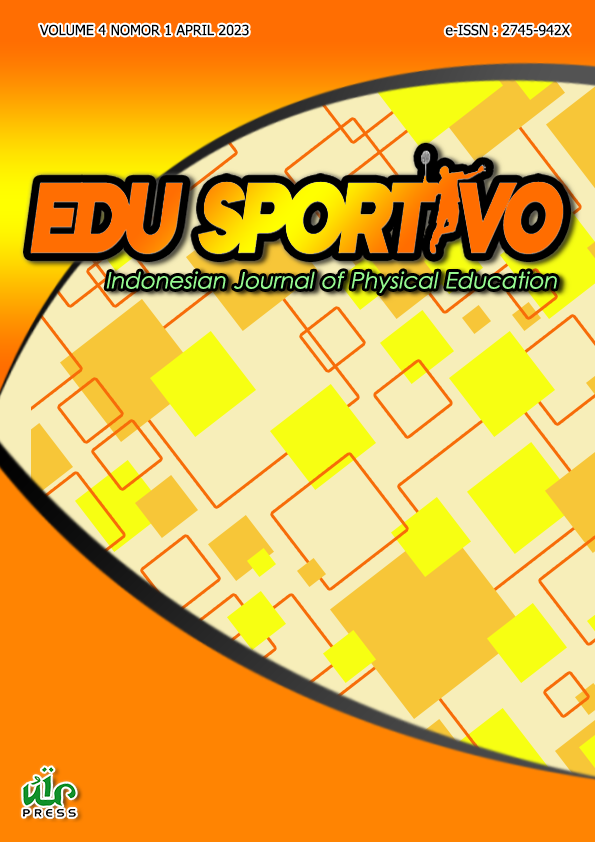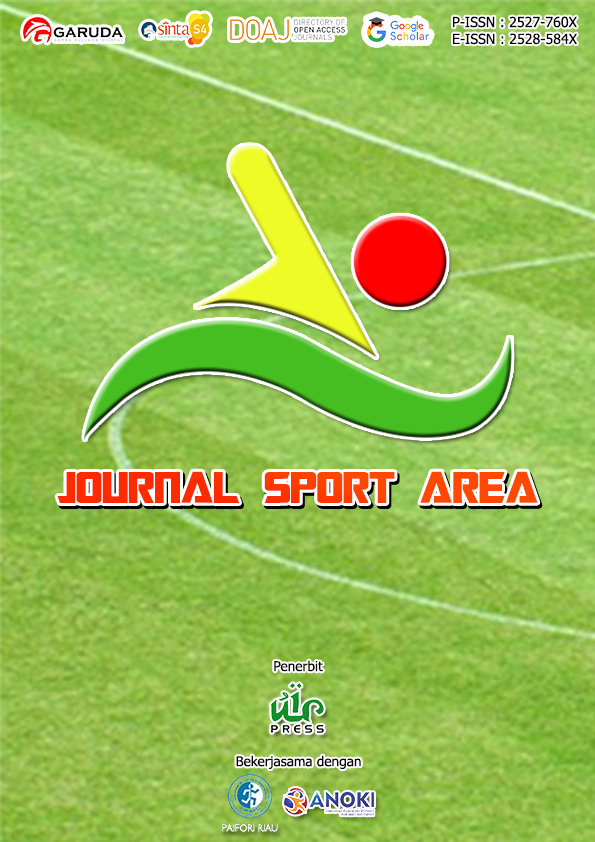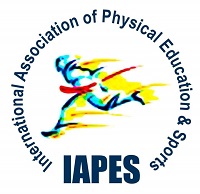Experiences of college students with physical impairment during online classes in physical education
Keywords:
Experiences, college students, online class, physical education, physically-impairedAbstract
Due to the rampant spread of COVID-19, schools have shut down worldwide, resulting in dramatic changes in education. Physically impaired students are one of the groups that were highly affected by these drastic changes. On a positive note, according to previously conducted studies, online physical education can provide students with disabilities a context in which self-efficacy and participation are promoted, which may lead to improved academic achievement. This qualitative-exploratory study is focused on unraveling the experiences and challenges of students with physical impairments during online PE classes amidst the pandemic. Ten (10) samples of college students within Pampanga, Philippines, participated in the study. This study has analyzed in-depth college students’ concepts, thoughts, and experiences during their online PE. Narratives from the participants were analyzed using manual qualitative analysis through transcriptions, coding, categorization, and thematic analyses. Based on the findings, three central themes have emerged: (a) becoming better, fitter, healthier, and happier; (b) overcoming challenges; and (c) having a healthy mind in a healthy body. Indeed, there is a need to ameliorate the delivery of acclimated or special needs physical education by making teachers more involved and dynamic in their tasks and lessons. PE teachers supervising students with physical impairments should determine their capacities and measures that need enforcement to support participation in sports and fitness. Aside from the findings discovered, an in-depth analysis of how academic performance, personality types, parental support, or sports participation can affect students’ perception or experience in online physical education classes is highly suggested.
Downloads
References
Ai, X., Yang, J., Lin, Z., & Wan, X. (2021). Mental Health and the Role of Physical Activity During the COVID-19 Pandemic. Frontiers in Psychology, 12(October), 1–8. https://doi.org/10.3389/fpsyg.2021.759987
Allam, F. C., & Martin, M. M. (2021). Issues and Challenges in Special Education: a Qualitative Analysis From Teacher’S Perspective. Southeast Asia Early Childhood Journal, 10(1), 2021–2058. https://doi.org/https://doi.org/10.37134/saecj.vol10.1.4.2021
Aylett, E., Small, N., & Bower, P. (2018). Exercise in the treatment of clinical anxiety in general practice – a systematic review and meta-analysis. BMC Health Services Research, 18(1), 559. https://doi.org/10.1186/s12913-018-3313-5
Banks, L. M., Kuper, H., & Polack, S. (2017). Poverty and disability in low- and middle-income countries: A systematic review. PLOS ONE, 12(12), e0189996. https://doi.org/10.1371/journal.pone.0189996
Berry, S. J., & Domene, J. F. (2015). Supporting Postsecondary Students With Sensory or Mobility Impairments in Reaching Their Career Aspirations. Career Development and Transition for Exceptional Individuals, 38(2), 78–88. https://doi.org/10.1177/2165143413490792
Bertills, K., Granlund, M., & Augustine, L. (2019). Inclusive Teaching Skills and Student Engagement in Physical Education. Frontiers in Education, 4(August), 1–13. https://doi.org/10.3389/feduc.2019.00074
Bertills, K., Granlund, M., & Augustine, L. (2021). Student Self-Efficacy and Aptitude to Participate in Relation to Perceived Functioning and Achievement in Students in Secondary School With and Without Disabilities. Frontiers in Psychology, 12(May), 1–13. https://doi.org/10.3389/fpsyg.2021.607329
Bikner-Ahsbahs, A. (2019). The Research Pentagon: A Diagram with Which to Think About Research (pp. 153–180). https://doi.org/10.1007/978-3-030-15636-7_7
Birt, L., Scott, S., Cavers, D., Campbell, C., & Walter, F. (2016). Member Checking. Qualitative Health Research, 26(13), 1802–1811. https://doi.org/10.1177/1049732316654870
Bloemen, M. A. T., Backx, F. J. G., Takken, T., Wittink, H., Benner, J., Mollema, J., & Groot, J. F. (2015). Factors associated with physical activity in children and adolescents with a physical disability: a systematic review. Developmental Medicine & Child Neurology, 57(2), 137–148. https://doi.org/10.1111/dmcn.12624
Carone, K. (2012, June 3). Online PE: Not Just a Virtual Workout | Getting Smart. https://www.gettingsmart.com/2012/01/03/online-pe-not-just-a-virtual-workout/
Clemente, I. (2017). Same but different: Barriers and facilitators to participation in physical activity for children with disability. Physiotherapy (United Kingdom), 97, eS1131.
Cook, C. R., Williams, K. R., Guerra, N. G., Kim, T. E., & Sadek, S. (2010). Predictors of bullying and victimization in childhood and adolescence: A meta-analytic investigation. School Psychology Quarterly, 25(2), 65–83. https://doi.org/10.1037/a0020149
de Hollander, E. L., & Proper, K. I. (2018). Physical activity levels of adults with various physical disabilities. Preventive Medicine Reports, 10, 370–376. https://doi.org/10.1016/j.pmedr.2018.04.017
Denisova, O. A., Lekhanova, O. L., & Gudina, T. V. (2020). Problems of distance learning for students with disabilities in a pandemic. SHS Web of Conferences, 87, 00044. https://doi.org/10.1051/shsconf/20208700044
Engzell, P., Frey, A., & Verhagen, M. D. (2021). Learning loss due to school closures during the COVID-19 pandemic. Proceedings of the National Academy of Sciences, 118(17). https://doi.org/10.1073/pnas.2022376118
Futurists Club Team. (2021, March 3). The science of well-being. Futurists Club by Science of the Time. https://medium.com/futurists-club-by-science-of-the-time/the-science-of-well-being-df1eb262bb8e
Gaetano, A. (2016). Relationship between physical inactivity and effects on individual health status. Journal of Physical Education and Sport, 16(2), 1069–1074. https://doi.org/10.7752/jpes.2016.s2170
Gallagher, M. W. (2012). Self-Efficacy. In Encyclopedia of Human Behavior (pp. 314–320). Elsevier. https://doi.org/10.1016/B978-0-12-375000-6.00312-8
Greer, T. L., Trombello, J. M., Rethorst, C. D., Carmody, T. J., Jha, M. K., Liao, A., Grannemann, B. D., Chambliss, H. O., Church, T. S., & Trivedi, M. H. (2016). Improvements in Psychosocial Functioning and Health-related quality of life following exercise augmentation in patients with treatment response but nonremitted major depressive order: Results from the tread study. Depression and Anxiety, 33(9), 870–881. https://doi.org/10.1002/da.22521
Holbrook, H. M., Voller, F., Castellini, G., Silvestri, C., Ricca, V., Cassioli, E., Ivanova, M. Y., & Hudziak, J. J. (2020). Sport participation moderates association between bullying and depressive symptoms in Italian adolescents. Journal of Affective Disorders, 271, 33–38. https://doi.org/10.1016/j.jad.2020.03.142
Jeong, H.-C., & So, W.-Y. (2020). Difficulties of Online Physical Education Classes in Middle and High School and an Efficient Operation Plan to Address Them. International Journal of Environmental Research and Public Health, 17(19), 7279. https://doi.org/10.3390/ijerph17197279
Jesamine, A., Dianito, P., Espinosa, J., Duran, J., Dianito, A. J., & Tus, J. (2021). A Glimpse into the Lived Experiences and Challenges Faced of PWD Students towards Online Learning in the Philippines Amidst COVID-19 Pandemic. Article in International Journal Of Advance Research And Innovative, 7(1), 1–25.
Jesina, O., Baloun, L., Kudlacek, M., Dolezalova, A., & Badura, P. (2022). Relationship of Exclusion From Physical Education and Bullying in Students With Specific Developmental Disorder of Scholastic Skills. International Journal of Public Health, 67(August), 1–8. https://doi.org/10.3389/ijph.2022.1604161
Kandola, A. A., Osborn, D. P. J., Stubbs, B., Choi, K. W., & Hayes, J. F. (2020). Individual and combined associations between cardiorespiratory fitness and grip strength with common mental disorders: a prospective cohort study in the UK Biobank. BMC Medicine, 18(1), 303. https://doi.org/10.1186/s12916-020-01782-9
Kandola, A., Vancampfort, D., Herring, M., Rebar, A., Hallgren, M., Firth, J., & Stubbs, B. (2018). Moving to Beat Anxiety: Epidemiology and Therapeutic Issues with Physical Activity for Anxiety. Current Psychiatry Reports, 20(8), 63. https://doi.org/10.1007/s11920-018-0923-x
Kolb, D. A. (2015). Experiential Learning: Experience as the Source of Learning and Development (2nd ed.). Pearson Education, Inc.
Lidor, R., & Hutzler, Y. (2019). Including Students with Disabilities in a Physical Education Teacher Preparation Program: An Institutional Perspective. In Teacher Education in the 21st Century. IntechOpen. https://doi.org/10.5772/intechopen.85268
Lobo, J. (2022). A sudden shift: Students’ perception of distance and online education in physical education amidst COVID-19 Pandemic. Edu Sportivo: Indonesian Journal of Physical Education, 3(3), 200–216. https://doi.org/10.25299/es:ijope.2021.vol3(3).9276
Lobo, J., Dimalanta, G., & Bautista, C. (2022). An Investigation on the Factors Affecting Students’ Interest in Physical Education Using Principal Component Analysis (PCA) at a Local City College in Angeles City, Pampanga, Philippines. American Journal of Multidisciplinary Research and Innovation, 1(2), 63–69. https://doi.org/10.54536/ajmri.v1i2.291
Lobo, J., Dimalanta, G., Bautista, C., Buan, E., & De Dios, D. Al. (2022). TikTok Consumption and Level of Class Engagement of Performing Arts Students in the New Normal: Destructive or Beneficial? American Journal of Education and Technology, 1(1), 1–9. https://doi.org/10.54536/ajet.v1i1.305
Macfarlane, J. (2013). Other physical consequences of disability. In Handbook of Clinical Neurology (Vol. 110, pp. 315–322). Elsevier. https://doi.org/10.1016/B978-0-444-52901-5.00026-5
Malecki, C. K., Demaray, M. K., Smith, T. J., & Emmons, J. (2020). Disability, poverty, and other risk factors associated with involvement in bullying behaviors. Journal of School Psychology, 78, 115–132. https://doi.org/10.1016/j.jsp.2020.01.002
Marron, S., Murphy, F., Pitsia, V., & Scheuer, C. (2021). Inclusion in Physical Education in primary schools in Europe through the lens of an Erasmus+ partnership. Education 3-13, 0(0), 1–16. https://doi.org/10.1080/03004279.2021.2002382
Mendes, M. de A., da Silva, I., Ramires, V., Reichert, F., Martins, R., Ferreira, R., & Tomasi, E. (2018). Metabolic equivalent of task (METs) thresholds as an indicator of physical activity intensity. PLOS ONE, 13(7), e0200701. https://doi.org/10.1371/journal.pone.0200701
Molina-Roldán, S., Marauri, J., Aubert, A., & Flecha, R. (2021). How Inclusive Interactive Learning Environments Benefit Students Without Special Needs. Frontiers in Psychology, 12(April). https://doi.org/10.3389/fpsyg.2021.661427
Nidheesh, M. . (2020, November 17). E-learning inadequate and ineffective: Azim Premji University study . Mint. https://www.livemint.com/education/news/e-learning-inadequate-and-ineffective-azim-premji-university-study-11605613250823.html
Norwich, B. (2022). Research about inclusive education: Are the scope, reach and limits empirical and methodological and/or conceptual and evaluative? Frontiers in Education, 7(July), 1–9. https://doi.org/10.3389/feduc.2022.937929
Oraif, I., & Elyas, T. (2021). The Impact of COVID-19 on Learning: Investigating EFL Learners’ Engagement in Online Courses in Saudi Arabia. Education Sciences, 11(3), 99. https://doi.org/10.3390/educsci11030099
Pans, M., Úbeda-Colomer, J., Monforte, J., & Devís-Devís, J. (2021). Physical Activity and Accomplishment of Recommendations in University Students with Disabilities: A Longitudinal Study. International Journal of Environmental Research and Public Health, 18(11), 5540. https://doi.org/10.3390/ijerph18115540
Pasay-An, E. A. (2015). Echoes of silence: The unheard struggles of the physically impaired learners in the mainstream education. Philippine Journal of Nursing, 85(2), 16–21.
Pellerin, S., Wilson, W. J., & Haegele, J. A. (2022). The experiences of students with disabilities in self-contained physical education. Sport, Education and Society, 27(1), 14–26. https://doi.org/10.1080/13573322.2020.1817732
Roldan, A., & Reina, R. (2021). Are Self-Efficacy Gains of University Students in Adapted Physical Activity Influenced by Online Teaching Derived From the COVID-19 Pandemic? Frontiers in Psychology, 12(April). https://doi.org/10.3389/fpsyg.2021.654157
Ross, S. M., Bogart, K. R., Logan, S. W., Case, L., Fine, J., & Thompson, H. (2016). Physical Activity Participation of Disabled Children: A Systematic Review of Conceptual and Methodological Approaches in Health Research. Frontiers in Public Health, 4(September), 1–10. https://doi.org/10.3389/fpubh.2016.00187
Salasac, C., & Lobo, J. (2022). Rising Popularity of TikTok During the Pandemic: Utilization of the Application Vis-À-Vis Students’ Engagement. American Journal of Interdisciplinary Research and Innovation, 1(2), 43–48. https://doi.org/10.54536/ajiri.v1i2.699
Schank, R. C., Berman, T. R., & Macpherson, K. A. (2013). Learning by doing. In Instructional-Design Theories and Models: A New Paradigm of Instructional Theory (Vol. 2). OCSLD. https://doi.org/10.4324/9781410603784-14
Schunk, D. H., & DiBenedetto, M. K. (2021). Self-efficacy and human motivation. In Advances in Motivation Science (Vol. 8, pp. 153–179). Elsevier Ltd. https://doi.org/10.1016/bs.adms.2020.10.001 (Corrected-Book section)
Shields, N., & Synnot, A. (2016). Perceived barriers and facilitators to participation in physical activity for children with disability: a qualitative study. BMC Pediatrics, 16(1), 9. https://doi.org/10.1186/s12887-016-0544-7
Shirazipour, C. H., Evans, M. B., Leo, J., Lithopoulos, A., Martin Ginis, K. A., & Latimer-Cheung, A. E. (2020). Program conditions that foster quality physical activity participation experiences for people with a physical disability: a systematic review. Disability and Rehabilitation, 42(2), 147–155. https://doi.org/10.1080/09638288.2018.1494215
Smith, P. K., López-Castro, L., Robinson, S., & Görzig, A. (2019). Consistency of gender differences in bullying in cross-cultural surveys. Aggression and Violent Behavior, 45, 33–40. https://doi.org/10.1016/j.avb.2018.04.006
Strohacker, E., Wright, L. E., & Watts, S. J. (2021). Gender, Bullying Victimization, Depressive Symptoms, and Suicidality. International Journal of Offender Therapy and Comparative Criminology, 65(10–11), 1123–1142. https://doi.org/10.1177/0306624X19895964
Stubbs, B., Vancampfort, D., Rosenbaum, S., Firth, J., Cosco, T., Veronese, N., Salum, G. A., & Schuch, F. B. (2017). An examination of the anxiolytic effects of exercise for people with anxiety and stress-related disorders: A meta-analysis. Psychiatry Research, 249, 102–108. https://doi.org/10.1016/j.psychres.2016.12.020
Taherdoost, H. (2016). Validity and Reliability of the Research Instrument; How to Test the Validation of a Questionnaire/Survey in a Research. International Journal of Academic Research in Management, 5(3), 28–36. https://doi.org/10.2139/ssrn.3205035
Tarantino, G., Makopoulou, K., & Neville, R. D. (2022). Inclusion of children with special educational needs and disabilities in physical education: A systematic review and meta-analysis of teachers’ attitudes. Educational Research Review, 36(April), 100456. https://doi.org/10.1016/j.edurev.2022.100456
Tegero, M. C. (2021). Challenges Encountered by Physical Education Teachers in Online Teaching in Times of COVID-19 Pandemic. International Journal of Research Publications, 91(1), 1–5. https://doi.org/10.47119/IJRP1009111220212595
Velasco, J. V., Obnial, J. C., Pastrana, A., Ang, H. K., Viacrusis, P. M., & Lucero-Prisno III, D. E. (2021). COVID-19 and persons with disabilities in the Philippines: A policy analysis. Health Promotion Perspectives, 11(3), 299–306. https://doi.org/10.34172/hpp.2021.38
Ware, A. (2022). Good reasons for embracing challenges. Abbotsleigh. Retrieved October 1, 2022, from https://www.abbotsleigh.nsw.edu.au/news/good-reasons-for-embracing-challenges
Published
How to Cite
Issue
Section
This is an open-access article distributed under the terms of the Creative Commons Attribution-ShareAlike 4.0 International License which permits unrestricted use, distribution, and reproduction in any medium. Users are allowed to read, download, copy, distribute, search, or link to full-text articles in this journal without asking by giving appropriate credit, provide a link to the license, and indicate if changes were made. All of the remix, transform, or build upon the material must distribute the contributions under the same license as the original.
Accepted 2022-11-19
Published 2022-12-20



.png)




















.png)







.png)





